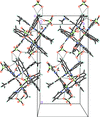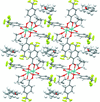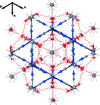issue contents
February 2022 issue

Cover illustration: A new layered silicate, Cs2SnIVSi6O15, forms serendipitously at high temperature via attack of the reagents (CaO, SnO, TeO2) and flux (NaCl/CsCl) on the silica reaction vessel. For ease of comparison with its Zr-containing analogue, the structure is described using an unconventional space-group setting, I2/c. See: Ketter & Weil [Acta Cryst. (2022). E78, 111–113].
Jerry P. Jasinski tribute
Download citation


Download citation


A tetranuclear complex with an open-cubane like structure was synthesized from 2-methoxy-6-(pyridin-2-yl-hydrazonomethyl)-phenol and characterized using micro-analytical and spectroscopic techniques, and single-crystal X-ray diffraction analysis.
CCDC reference: 2096266
Download citation


Download citation


The title Eu complex, featuring both Anthracac and trispyrazolylhydroborato ligands, exhibits an octavertex square-pyramidal coordination environment.
CCDC reference: 2143190
Download citation


Download citation


A cobalt sulfate complex supported by β-picoline ligands produces a unique cuboidal tetramer.
CCDC reference: 2143864
research communications
Download citation


Download citation


The crystal structure of Cs2SnSi6O15 shows a klassengleiche group–subgroup relationship of index 2 with Cs2ZrSi6O15.
CCDC reference: 2130669
Download citation


Download citation


The ability of 4-[(benzylamino)carbonyl]-1-methylpyridinium to form salts with halogenide anions was studied and Hirshfeld surface analysis to identify intermolecular interactions was performed.
Download citation


Download citation


The title compound is a cyclobutyl compound that adopts a Z configuration. The molecular structure is stabilized by an N—H⋯O hydrogen bond, forming an ![[S_{1}^{1}]](/e/issues/2022/02/00/jq2012/teximages/jq2012fi1.svg) (7) ring motif. In the crystal, molecules are linked by pairs of O—H⋯N hydrogen bonds, forming supramolecular ribbons linked via C11(9) ring motifs.
(7) ring motif. In the crystal, molecules are linked by pairs of O—H⋯N hydrogen bonds, forming supramolecular ribbons linked via C11(9) ring motifs.
CCDC reference: 1953658
Download citation


Download citation


In the title compound, one of the fused pyrazole rings adopts an envelope conformation while the other displays a twisted conformation. In the crystal, the molecules are linked by C—H⋯O hydrogen bonds and aromatic π–π interactions.
CCDC reference: 2131209
Download citation


Download citation


Ammonium chlorides, such as the title compound (S)-N-methyl-1-phenylethan-1-amnonium chloride (1), usually represent by-products in amination processes of chlorosilanes. Hirshfeld surface analysis and Hirshfeld atom refinement (HAR) were performed to obtain detailed information about the crystal packing and the exact position of the hydrogen atoms of compound 1.
CCDC reference: 2132333
Download citation


Download citation


α-Aminosilanes are distinguished by a long Si—C bond, which was confirmed in the title compound. Additionally, the supramolecular interactions were determined by Hirshfeld surface analysis to investigate the influence of these contacts on the crystal packing.
CCDC reference: 2131144
Download citation


Download citation


The structure of the racemic form of the diuretic drug trichlormethiazide was determined from laboratory X-ray powder diffraction data: the extended structure features an intricate combination of N—H⋯O hydrogen bonds and π–π and C—Cl⋯π interactions.
CCDC reference: 2034096
Download citation


Download citation


The molecular and crystal structure of a ferrocenyl derivative with an undecyl-1,11-diol chain on one cyclopentadienyl ring is reported: O—H⋯O, C—H⋯O and C—H⋯π(ring) contacts occur in the extended structure.
CCDC reference: 2130725
Download citation


Download citation


The quadruple-bond complex, [Mo2(p-O2CC6H4CF3)4·2THF], crystallizes in the triclinic space group P![[\overline{1}]](/e/issues/2022/02/00/mw2183/teximages/mw2183fi1.svg) with intercalated pentane/THF lattice solvent molecules. The electron-withdrawing group on the paddlewheel carboxylate together with the axial THF molecules lead to a slight lengthening of the metal–metal bond, as predicted by Cotton.
with intercalated pentane/THF lattice solvent molecules. The electron-withdrawing group on the paddlewheel carboxylate together with the axial THF molecules lead to a slight lengthening of the metal–metal bond, as predicted by Cotton.
CCDC reference: 2132473
Download citation


Download citation


A three-dimensional coordination polymer, poly[hexaaqua(μ4-glutarato)bis(μ3-sulfato)dineodymium(III))], [Nd2(H2O)6(glutarato)(SO4)2]n (glutarato2– = C5H6O22–), consisting of cationic {Nd2(H2O)6(SO4)2}n2n+ layers linked by glutarate ligands, was synthesized by the microwave-heating technique.
CCDC reference: 2107848
Download citation


Download citation


The crystal structure of the title compound was redetermined at two temperatures [120.0 (2) and 295.0 (2) K]. The previously reported P212121 chiral space group is corrected to centrosymmetric Pbca.
Download citation


Download citation


N-methylation of the perimidine core results in an increase of the interplanar angle between the perimidine and aryl rings. The crystal packing of the unsubstituted perimidine is formed by hydrogen bonding and π–π stacking while molecules of its N-substituted analog are assembled by C—H⋯π interactions.
Download citation


Download citation


NiII ions templated the condensation of aminoguanidine with two different aldehyde molecules with the formation of a new molecular nickel(II) complex with a tetradentate chelating ligand.
CCDC reference: 1958727
Download citation


Download citation


In the title compound, C20H23NO, the piperidine ring adopts a distorted boat conformation, while the phenyl rings subtend a dihedral angle 65.1 (2)°. In the crystal, molecules are linked by C—H⋯O hydrogen bonds into chains extending along the b-axis direction.
CCDC reference: 2133146
Download citation


Download citation


Crystal structures of three N,N,N′-trisubstituted thioureas, with varying substitution patterns, for reactivity-controlled nanocrystal synthesis are reported.
Download citation


Download citation


The use of the H2S scavenger monoethanolamine triazine in a natural gas treatment facility produced a new Pbca polymorph (form II) of 2-(1,3,5-dithiazinan-5-yl)ethanol featuring O—H⋯N hydrogen-bonded dimers rather than one-dimensional, helical O—H⋯O strands as reported previously for the I41/a (form I) polymorph.
Download citation


Download citation


In the title adduct, two 3,5-dinitrosalicylic acid molecules in the dianionic (DNSA2−) form, two protonated piperazine-1,4-diium cations (PIP2+) and a neutral piperazine molecule (PIP) along with two water molecules are found in the asymmetric unit. The crystal structure of the title adduct is reported, and hydrogen-bonding interactions are discussed.
CCDC reference: 2132861
Download citation


Download citation


Single crystals of a novel boride silicide, Na3MgB37Si9, containing B12 icosahedra and Si8 units were synthesized from Na, B, Si, B2O3 and magnesium vapor.
CCDC reference: 2141726
Download citation


Download citation


The isolation and characterization of an isopolytungstate anion [W12O40(OH)2]10– (paradodecatungstate B) with sodium and protonated serinol entities [Na6((CH2OH)2CHNH3)4]10+ as counter-cations are reported.
CCDC reference: 2121767
Download citation


Download citation


The molecular and crystal structures of 2-(3-hydroxypropyl)-1H-benzimidazole and of its nitrate salt have been studied. Hirshfeld surfaces and fingerprint plots were generated to investigate the intermolecular interactions.
Download citation


Download citation


The crystal structure of the title polymeric coordination compound, {[FePt(CN)4(H2O)2]·1.33CH3OH}n, features a framework structure with pores in which disordered methanol solvent molecules are situated.
CCDC reference: 2142647
Download citation


Download citation


The 4-methoxyphenyl group is disposed on one side of the bicyclic core and the oxygen atoms of the hydroxyl and acetyl groups are disposed on the other. The unsaturated portion of the core adopts an envelope conformation. In the crystal, O—H⋯O and C—H⋯O hydrogen bonds form chains extending along the a-axis direction. These are linked into layers parallel to the ac plane by additional C—H⋯O hydrogen bonds and C—H⋯π(ring) interactions.
CCDC reference: 2141278
Download citation


Download citation


The asymmetric unit of the title molecule consists of four molecules that differ primarily in the orientations of the styryl and the N-phenylcarboxamido groups.
CCDC reference: 2143707
Download citation


Download citation


The molecular and crystal structures of the anhydrous form of 5-amino-1H-benzimidazole-2(3H)-thione were determined. Hirshfeld surfaces and fingerprint plots were studied.
CCDC reference: 2143895


 journal menu
journal menu













































